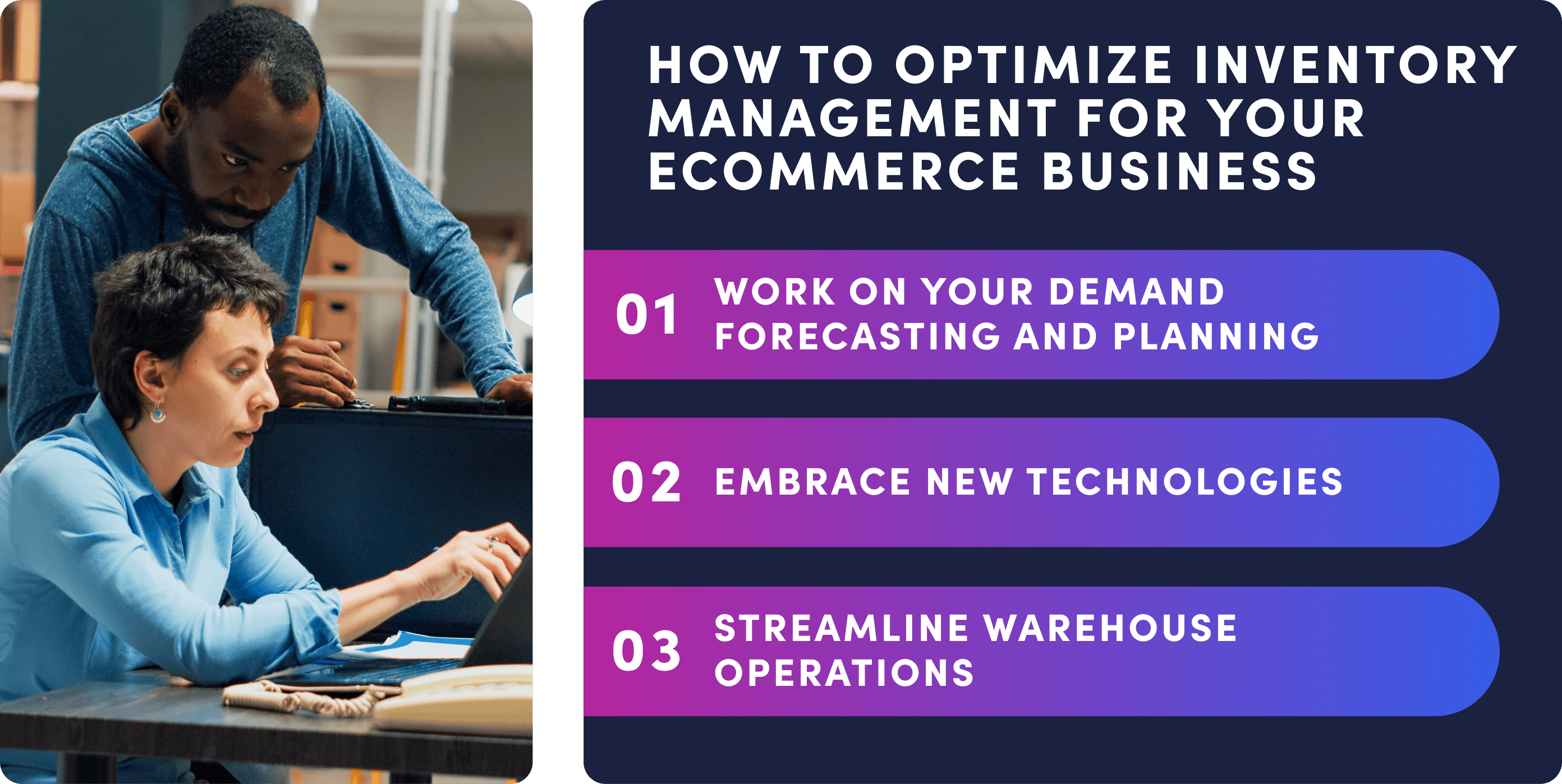-
Effective inventory management is crucial: It helps prevent stockouts, avoid overstock problems, keep customers happy, and optimize profitability, avoid overstock problems, keep customers happy, and optimize profitability.
-
Key components of inventory management: Inventory tracking, demand forecasting, reordering and replenishment, SKU management, warehouse management, and returns logistics are essential elements to consider when managing inventory effectively.
-
Embracing new technologies like digitization, artificial intelligence (AI), and the Internet of Things (IoT) can streamline inventory management processes, improve accuracy, and provide real-time insights.
Imagine: A customer spends hours searching for the perfect gift for a loved one.

They carefully research different brands, read reviews, and compare prices. They finally make their choice and hit "order."
One day later, they receive an email. The product they ordered is out of stock, and the order has been delayed or canceled.
You don't want to provide this experience if you want customers to order from your company again. That's where the power of effective inventory management comes into play. Strong inventory management not only helps avoid lousy customer experience. It's also an opportunity to optimize operations and maximize revenue.
Ready to learn more about the importance of inventory management and get our top tips for success? We've got just the guide for you.
What is Inventory Management?
Inventory management is the art of controlling, managing, and optimizing the levels of your products in stock. The main goal is to meet customers' demands while keeping costs low and avoiding unnecessary overstocking. Let's take a closer look at the key components:
- Inventory Tracking. This involves keeping a close eye on the location of your products and the inventory levels in real time. It's all about having accurate visibility and efficient management of your stock.
- Demand Forecasting. By analyzing customer behavior and market trends, you can anticipate the order volumes and be well-prepared to fulfill those customer orders.
- Reordering and Replenishment. Maintaining a balanced inventory is key. Setting optimal reorder points and safety stock levels means you don't run out of stock or have excessive inventory.
- SKU Management. Each product and its variants need their own unique identifiers. This helps you track them precisely and effectively control your inventory.
- Warehouse Management. Think of it as organizing your inventory storage smartly. It's all about maximizing space, reducing handling costs, and streamlining the process of fulfilling orders.
- Returns Logistics. Customers return products. You need proper procedures for inspecting, sorting, and restocking the returned stock.
When it comes to managing inventory, there are various approaches you can adopt. For instance, the ABC approach categorizes inventory based on the value and importance of products. It lets you prioritize your efforts by focusing on high-value and in-demand products ("A" items). You dedicate fewer resources to lower-value items.
You can also organize your stock in different ways. For example, there's the First In, First Out (FIFO) method, where you sell the oldest stock first. Alternatively, you can opt for the Last In, First Out (LIFO) method to sell the newest stock first. Another approach is Just-in-Time (JIT) inventory management, where you receive stock shortly before you need it for order fulfillment.
And if you really want to simplify things, some business owners choose drop shipping. It's a method where you pass customer orders directly to suppliers for shipping. That way, you don't need to think about inventory storage and management.

Why Ecommerce Inventory Management Matters
A smart inventory management system for your ecommerce business is incredibly important. It plays a key role in ensuring a fantastic customer experience and keeping your expenses under control. Let's explore why it truly matters.
Prevent Stockouts
At a basic level, an effective inventory management process helps prevent expensive mistakes. Running out of popular products wastes marketing efforts and can anger customers.
Sometimes, businesses may have to scramble to buy additional inventory at the last minute. That can be expensive or even impossible, depending on your supply chain.
Take the example of Mission Produce. They specialize in distributing ripe avocados throughout the year.
During their transition to a new ERP system, they encountered inventory issues. They lost track of the quantity and ripeness levels of their avocados. As a result, they had to purchase avocados from other retailers just to meet their delivery commitments. This unexpected expense took a hefty chunk out of their profits.
Steer Clear of Dead Stock
Overstocking can be a costly problem resulting in dead stock—inventory that remains unsold or obsolete. It's a particularly risky situation for businesses that deal with perishable goods. I mean, who wants to be stuck with thousands of rotting avocados?
But it's not just limited to perishable goods. Holding onto outdated products can also lead to financial losses in other industries. Take fashion, for instance. Clothes can quickly become obsolete, leaving you with inventory that nobody wants.
Keeping Customers Happy
You can provide accurate information across your sales channels when you have a solid grip on your inventory. With inventory control, you can make sure in-demand products are always available. It also helps you fulfill orders on time, keeping your customers happy and satisfied.
Become More Profitable
By utilizing inventory data effectively, ecommerce brands can optimize their profitability. Correct stock levels mean you don't need to pay extra for expedited shipping. It also reduces the pressure on staff to meet delivery deadlines.
Additionally, inventory management enables you to identify slow-moving or low-margin products. Then, you can make informed decisions about which products you stock.
How to Optimize Inventory Management For Your Ecommerce Business

We've put together three ways to improve your inventory management strategy.
1. Work on Your Demand Forecasting and Planning
Effective inventory management, crucial for ecommerce businesses, relies on good forecasting. When you know how many orders you're likely to receive, you can make sure your business is well-prepared to fulfill them.
Consider internal factors such as demand history and external factors like market trends, weather, and holidays. Analyzing historical sales data gives you insights into customer behavior. That helps you make more accurate predictions. Dive into your past data to identify patterns, market trends, and seasonality.
Stay updated with changing trends and customer preferences by conducting market research and engaging with your customers. Ask customers for feedback by running surveys and monitoring reviews. Scour social media to find out what your audience is thinking about.
Collaborating with sales and marketing teams is another way to understand customer demand better. Often sales and marketing have more direct customer interactions than ops teams like demand planning. Ask your colleagues to share any relevant on-the-ground feedback from customers. Customer responses to marketing campaigns can also give you insights into emerging trends.
2. Embrace New Technologies
New technologies make inventory management solutions faster and easier. They also reduce the impact of human error.
What's more, failing to adopt such technology while your competitors do can put your business at a disadvantage. You risk falling behind in the competitive market.
Let's look at a few examples of how new technology can help with inventory management.
Digitization. Learning about your business is easier when you don't have to rifle through a stack of papers. Digital data means businesses can make decisions based on fact rather than opinion, guesswork, or habit.
Artificial intelligence, specifically machine learning (ML). ML systems continuously learn from historical data, which means they can make accurate predictions about what will happen in the future. Demand planning software that uses ML streamlines the forecasting process and gives you more accurate inventory forecasting.
The Internet of Things (IoT). IoT is a set of devices that have sensors, software, and connectivity capabilities, allowing them to collect and exchange data. Businesses can use RFID tags (a kind of barcode) for real-time inventory monitoring and location tracking. Real-time data analysis also lets companies provide customers with accurate product availability and delivery information. It also opens up the possibility of inventory system automation. The best technology and software for your business will depend on your organization's specific needs.
When you want to add a new tool or inventory management software, consider these factors:
- Scalability. Make sure the technology can grow with you
- Integration. Check if the functionality is compatible with the systems and processes you already use
- User-Friendliness and Accessibility. Choose solutions that are easy to use and offer mobile accessibility if your team needs to work on the go
- Customization. Look for technology that you can tailor to your specific needs
3. Streamline Warehouse Operations
Warehousing is probably not the most glamorous part of your online store. While many customer experiences are being digitized, it's easy to forget about the physical side of order management. But warehouses are the backbone of your ecommerce business, which means warehouse optimization matters.
Alongside using technologies like RFID tags, you should give ongoing employee training so staff can use any new tools properly. Organizing the warehouse layout based on demand and storing frequently ordered items closer to packing and shipping areas can minimize travel time.
Try out new workflows. For example, in batch picking, multiple orders with similar items or locations are consolidated into a single picking batch. Zone picking is an alternative that assigns specific zones to pickers for parallel order processing.
Foster a Data-Driven Culture in All Parts of Your Ecommerce Brand
Data helps to improve the behind-the-scenes operations in ecommerce. But it can also help ecommerce brands to deliver a customer-centric experience in other ways.
For instance, you can group customers based on their buying behavior and tailor your marketing to different cohorts. You might analyze patterns in customer service interactions to make your customer support more proactive. If you know how customers usually behave, you can address concerns before they escalate.
Data also enables you to understand customer preferences better. That way, you can deliver personalized recommendations to help you sell more. Learn more about how Rebuy's personalization platform fuels data-driven shopping experiences that accelerate growth for ecommerce brands.
•••
Try Rebuy free and see why the world’s top brands use Rebuy to accelerate sales growth.
Interested in partnering with Rebuy? Let's do it.
To keep up with the latest trends, platform updates, and more, follow us on LinkedIn.
